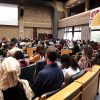Friday, May 10, 2024
News and Views from the Global South
RIGHTS: Getting Harassment on the Map
IPS Correspondents*
- Less common but perhaps more useful than the tourist map is the ‘harassment map’ that many Cairo women are beginning to refer to.

Fabian Bolano (far right) performs street outreach as part of the Safe Cities Programme in Rosario, Argentina. Credit: Hilary Duffy/UNIFEM
The launch Monday of the Global Programme on Safe Cities Free of Violence against Women by UNIFEM (United Nations Development Fund for Women) in several cities is intended to strengthen and encourage efforts already in place, and bring in more.
In Egypt, activists have found a hi-tech weapon in the battle against sexual harassment, which many women face daily.
HarassMap, a private initiative run by volunteer activists, allows women who have been subject to harassment to report the incident anonymously by SMS, e-mail or online social networking sites. The information is compiled into a database that utilises open-source mapping technology to create a digital map of harassment “hotspots” in Cairo and other Egyptian cities.
“One of the most frustrating things about sexual harassment in Egypt is that it often happens in busy areas in broad daylight because there are no consequences or intervention,” says Rebecca Chaio, one of the project’s co-founders. “A main goal of HarassMap is to change the social acceptability of sexual harassment by breaking the silence… and by providing data to help tackle the problem.”
HarassMap utilises Ushahidi, a software platform initially developed to map citizen reports of post-election violence in Kenya in 2008. The software depicts the geographic spread and frequency of sexual harassment in real-time on a public website.
“The map will help women to avoid trouble spots…and will be provided to police and advocacy groups so they can increase their presence in these areas,” explains Chaio.
A study published in 2008 by the Egyptian Centre for Women’s Rights (ECWR) found that 83 percent of Egyptian women surveyed said they had experienced some form of sexual harassment, including groping, stalking, verbal abuse and indecent exposure. Some 46 percent of women reported being harassed on a daily basis.
The study revealed that, contrary to public opinion, the harassment did not appear to be a consequence of the woman’s style of dress. Over two-thirds of victims were wearing the Islamic headscarf when incidents occurred.
Dozens of videos have been uploaded to websites to demonstrate the extent of sexual harassment and police lethargy in responding to complaints. The imagery, and a flurry of negative press reports, have shamed the government into taking the issue more seriously, say activists.
“The police used to just sit by and let men attack women,” says Nehad Abu El-Komsan, chairwoman of ECWR. “But lately security has improved and when women ask for assistance, police are now willing to help them.”
In New Delhi in India, women’s rights organisations have focused much attention on programmes targeting bus crews.
The Delhi state government has partnered with ‘Jagori’, a well-known non-governmental organisation (NGO), and UNIFEM to run gender sensitisation programmes for the state-run Delhi Transport Corporation, which employs 3,600 drivers and bus conductors.
According to a survey conducted by the Centre for Equity and Inclusion (CEQUIN), an NGO, 82 percent of Delhi’s women see buses as the place they are mostly likely to be groped or sexually harassed.
“There is a need to see beyond rape and make sure that sexual harassment in buses and public places is treated as a serious issue and does not go unaddressed,” Lora Prabhu, the director of CEQUIN, told IPS.
Delhi’s minister for women and child development Kiran Walia said she was examining the possibility of installing surveillance cameras inside buses, and pressing for more stringent laws that would make sexual harassment a non- bailable offence.
Walia plans to strengthen an inititive called ‘Safe Delhi for Women’ by seeing that more women are recruited into the police force and by running programmes aimed at inculcating better public behaviour among young people.
In Quito, Ecuador, as in Delhi and elsewhere, women continue to be vulnerable on public transport.
María Caiza, 34, who lives in Calderón, a working-class and lower-middle-class neighbourhood on the northeast side of Quito, says “the streets are disquieting”. She commutes to her job as a domestic worker in an upscale part of town.
“We women go out to work, and men think that because they’re men, they can touch you, or worse,” says Caiza. “We protect each other at the bus stops, but we also put up with a lot. We should protest and demand safety, but it’s as if we don’t dare to.”
Quito, a city of 2.4 million people, was chosen for the UNIFEM programme because of the high level of gender violence in both the public and private spheres, and an institutional context favourable to the creation of instruments to combat it.
Eight out of 10 Ecuadoreans have suffered psychological, physical or sexual violence, according to official statistics.
Ninety-four out of 100 people who file domestic violence complaints in the city are women, and last year there were 287 sexual attacks against women, compared to just 16 against men.
“Where I live, there have been rapes in back streets,” 13- year-old Michelle Loachamín told IPS, sitting in a plaza with her classmates near their school.
It’s difficult when she gets off the bus on her way home. “I’m scared, any man who approaches makes me nervous if I’m alone,” she said. Besides sticking to well-lit main streets, she doesn’t frequent plazas or parks alone, “except for this one, which is next to the school and we are a big group of girls together.”
María Cecilia Pérez, who was director of social inclusion and gender in the Quito city government until 2009, told IPS that “The entire city is unsafe, but it is even more so for women.”
There have been moves to make it safer. “The city government has made an effort to bring lighting to parks and recreational areas, and has coordinated patrolling duties with the police,” she said.
But more work is needed to help the vulnerable segments of the population, especially young people, organise themselves in order “to maintain parks and other public spaces, and keep them safe,” she added.
The city government has passed an ordinance guaranteeing “safe access to public spaces for young people,” without leaving all the work up to the police.
Seven “centres of equity and justice” have been operating in Quito for the past 15 years, to address the problems of gender violence and child abuse, as well as problems like human mobility and public spaces. Specialised police units and courtrooms have also been set up.
In some of the poorer cities, the problems are inevitably more acute, and the solutions immeasurably more difficult. Mujawayezu, a resident of the Rwandan capital Kigali, is 38. She survives by selling fruits and vegetables around the city, and lives with her three children.
Harassment here often takes the form of criminality. “Criminal gangs used to harass and threaten me to give them something from my daily income or they would not allow me to run my business,” says Mujawayezu. “Most times I was obliged to pay the gangs a small amount from my daily income to protect my business.”
Most of the gang members threatening her were also her neighbours, she says.
Things began to turn around in 2009 for Mujawayezu and other women like her when the government began installing a general network of public lighting in all the suburban areas. The public lighting programme fell within the framework of a policy to improve security and social basic conditions for the population.
“For most women working in the informal sector it was bad before because of the gangs, but the situation has now improved,” she says.
“We now have police in the community. We live side by side with police officers, and we are at least feeling safe and protected now,” says Mujawayezu.
*Cam McGrath in Cairo, Ranjit Devraj in Delhi, Gonzalo Ortiz in Quito and Aimable Twahirwa in Kigali contributed to this report.

 Print
Print



